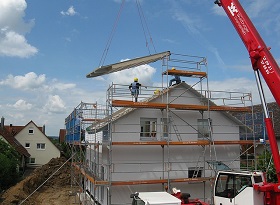Domestic building
The term 'domestic building' refers to a dwelling that has no more than one family unit resident in it, and which is used as a place of permanent or semi-permanent habitation.The most common example of a domestic building is a house.
The term ‘non-domestic building’ refers to any building that is not a domestic building.
A domestic building tends to be home to a ‘household’, which was defined in the 2011 Census as being: ‘one person living alone; or a group of people (not necessarily related) living at the same address who share cooking facilities and share a living room or sitting room or dining area’.
By contrast, the term ‘residential building’ has a wider application and can be used to refer to blocks of flats, homes of multiple occupancy (HMOs), institutions (e.g. hospitals, care homes, prisons), hotels, hostels, student halls of residence, and so on.
[edit] Related articles on Designing Buildings
- Agraharam.
- Apartment.
- Building performance evaluation in domestic buildings.
- Dwellinghouse.
- English Housing Survey 2018-19 reports released.
- Flat definition.
- House.
- Household.
- How much does it cost to sell my home.
- Living room.
- Manual to the Building Regulations.
- Mud room.
- Pantry, buttery, larder and scullery
- Proposed changes: MHCLG consultation on house building statistics.
- Residential definition.
- RIBA domestic building contract.
- Sheltered housing definition.
- Terraced house.
- Types of building.
- Types of dwelling.
- Use class.
Featured articles and news
RTPI leader to become new CIOB Chief Executive Officer
Dr Victoria Hills MRTPI, FICE to take over after Caroline Gumble’s departure.
Social and affordable housing, a long term plan for delivery
The “Delivering a Decade of Renewal for Social and Affordable Housing” strategy sets out future path.
A change to adoptive architecture
Effects of global weather warming on architectural detailing, material choice and human interaction.
The proposed publicly owned and backed subsidiary of Homes England, to facilitate new homes.
How big is the problem and what can we do to mitigate the effects?
Overheating guidance and tools for building designers
A number of cool guides to help with the heat.
The UK's Modern Industrial Strategy: A 10 year plan
Previous consultation criticism, current key elements and general support with some persisting reservations.
Building Safety Regulator reforms
New roles, new staff and a new fast track service pave the way for a single construction regulator.
Architectural Technologist CPDs and Communications
CIAT CPD… and how you can do it!
Cooling centres and cool spaces
Managing extreme heat in cities by directing the public to places for heat stress relief and water sources.
Winter gardens: A brief history and warm variations
Extending the season with glass in different forms and terms.
Restoring Great Yarmouth's Winter Gardens
Transforming one of the least sustainable constructions imaginable.
Construction Skills Mission Board launch sector drive
Newly formed government and industry collaboration set strategy for recruiting an additional 100,000 construction workers a year.
New Architects Code comes into effect in September 2025
ARB Architects Code of Conduct and Practice available with ongoing consultation regarding guidance.
Welsh Skills Body (Medr) launches ambitious plan
The new skills body brings together funding and regulation of tertiary education and research for the devolved nation.
Paul Gandy FCIOB announced as next CIOB President
Former Tilbury Douglas CEO takes helm.
UK Infrastructure: A 10 Year Strategy. In brief with reactions
With the National Infrastructure and Service Transformation Authority (NISTA).























